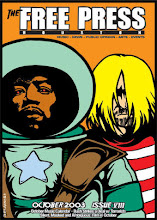
The Girl With the Dragon Tattoo arrives with the pedigree of a series of international best sellers of which this, the first of the novels, is based. Even without the books the movie plays well enough on its own merit with its rugged leading man, Michael Nyqvist (As It Is In Heaven) as a besieged reporter and Noomi Rapace, punked out as the titular femme. The Swedish title, Män som hatar kvinnor (2008), translates as Men Who Hate Women.
Three Swedish films have already been adapted from the novels and have already stirred Hollywood interest in a remake. In a way that’s good and bad. Between the Red Riding Trilogy and Girl With the Dragon Tattoo it's an exemplary year for mystery thrillers. On one hand the American remake is currently attached to David Fincher, not exactly a slouch when it comes to cinematic mayhem. Yet the small distributor of The Girl With the Dragon Tattoo, Music Box has excelled at foreign films released domestically, in particular the French thriller Tell No One. Like many American proposed remakes of Euro films it's a crapshoot whether the film will ever be made. Look what happened with Insomnia, the American remake didn't capture the nuances of the original despite being helmed by one of this decade's top directors Christopher Nolan. Another remake of a Swedish film currently in pre-production, Let The Right One In, could be great or another example of xenophobia. Of course that film features Chloe Moretz the star of Kick Ass itself a culture altering force so who's to say what will be remembered years down the road.
Sure any combo of American stars could make a Girl reboot a success, let's say George Clooney although he's not as rough looking as Nyqvist who himself reminds of 1970s Oliver Reed. Or Kristen Stewart as the girl, surely Stewart has proved her ability to get to the spine of a character. Still, the overwhelming urge at the end of seeing The Girl With the Dragon Tattoo was knowing that I would someday see these two lead characters come together again in the two sequels already made.
Nyqvist as Mikael Blomkvist a go-for-broke journalist for a widely read magazine has been accused of plagiarism and because of his high profile status he's considered by a shadowy entrepreneur to investigate a decades-old murder that involves members of his family. To vet Blomkvist, a lawyer involved with the cover corporation hires a computer hacker (Rapace, playing Lisbeth Salander) who provides al the details of his financial and personal life. Salander's so into the person she's investigating she eventually hooks up with Blomkvist as the investigation itself leads to corporate skullduggery, ritualized serial killings and even Nazi sympathizers.
A major subplot that unfolds during the first half has Salander being sexually abused by her trust fund benefactor. When she turns the tables, so to speak, the film launches into areas both salacious and perverted. But this feeds into the main storyline involving how Blomkvist comes to not only discovers the identity of the murderer but becomes their captive. At the same time, in a paper chasing frenzy Salander comes to her own conclusion as to the killer's identity and director Niels Arden Oplev pulls a chilling dissolve to the antagonist's face.
The Girl With the Dragon Tattoo constantly challenges the audience while giving them cinematic thrills. You need look no further for a great evening at the movies.













